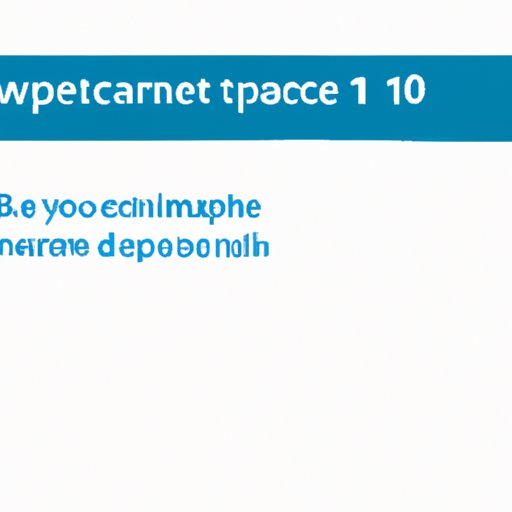
Introduction
Windows 10 is an efficient operating system that provides an optimal user experience. However, with regular usage, the device tends to get slower due to various reasons, including an overloaded cache. Cache is the temporary storage where browsers and applications store data to reduce loading times. Although cache speeds up your device, it becomes overwhelming after months of accumulated data. Clearing cache on Windows 10 can help increase the efficiency and speed of your device. In this article, we will guide you through the process of clearing cache on Windows 10, and explain why it is important to maintain your device regularly.
Computer Maintenance 101: The Importance of Clearing Cache on Windows 10
A cache is a volatile storage space that temporarily stores data from your browser or application. When you regularly access sites or apps on your device, it stores their data in the cache to reduce loading times, ultimately speeding up your device’s performance. However, with time, an overload of cache data can cause issues with your device, leading to a slow computer or an inefficient system. Clearing cache regularly can help optimize your device’s functionality, improve its overall performance and reduce the risk of system errors.
Maximizing Your Windows 10 Experience: How Clearing Your Cache Can Boost Your Computer’s Performance
Clearing cache on Windows 10 can benefit your device’s overall performance as cookies, temporary files, website data, etc., can pile up in the cache and lead to slow browsing speeds or even crashes. Clearing cache helps release disk space, which in return leads to more storage on the machine. With a stable and well-maintained device, web browsing speeds will increase, and the overall performance of the device will improve.
Clearing cache also helps prevent data breach instances, which may happen due to unsecured website data stored in cache. By removing such data, you’re making sure your machine stays secure.
Step-by-Step Guide to Clearing Your Cache on Windows 10: Keeping Your Device Running Smoothly
Clearing cache on Windows 10 is a simple process that requires a few steps:
- Open the Start menu and select ‘Settings.’
- Click on ‘System,’ then ‘Storage.’
- Press ‘Temporary Files’ found on the ‘Storage’ page.
- Locate ‘Cached data and files’ and click on it to delete the stored data.
- If you want to delete more data, you can select the other file types you want to delete, then click on ‘Remove Files.’
You can also clear your cache using your browser’s settings:
Google Chrome
- Open Chrome and click on the three dots icon in the upper-right corner of the screen.
- Select ‘Settings.’
- Click on ‘Privacy and security.’
- Press ‘Clear browsing data.’
- Check the boxes beside ‘Cached images and files’ and any other data you want to delete, then click on ‘Clear data.’
Microsoft Edge
- Open Edge and click on the three dots icon in the upper-right corner of the screen.
- Select ‘Settings.’
- Click on ‘Privacy, search and services.’
- Press ‘Choose what to clear’ under ‘Clear browsing data.’
- Check the boxes for ‘Cached data and files’ and any other data you want to delete, then click on ‘Clear now.’
Out with the Old, In with the New: Clearing Cache on Windows 10 for a Refreshed Computing Experience
Clearing cache on Windows 10 gives your device a fresh start by removing all the temporarily stored data. It also helps clear out any old website data that may have been accumulating in your cache causing unnecessary load on your RAM.
Old cache data can also cause performance issues when you’re using applications, such as online banking or e-commerce portals of websites like Amazon. Clearing cache on Windows 10 will ensure that your cache is updated with the latest data and safeguards your device from any future security issues.
To take advantage of the benefits of cache clearing, it is essential to clear your cache regularly, at least once every week. This will help maximize your device’s performance and longevity.
Why Clearing Your Cache is the Solution to Your Windows 10 Performance Issues: Tips and Tricks
If you’re experiencing slow performance issues with your Windows 10 computer, clearing cache data can be the solution to the problem. Here are a few more tips and tricks to help with performance issues:
- Regularly update your system and download the latest drivers to improve device functionality.
- Remove any unwanted applications or software that may be leading to slow performance and wasting disk space.
- Use high-quality antivirus software to prevent malware and viruses from slowing your system.
- Avoid excessive multi-tasking, which can lead to CPU overload.
The Ultimate Guide to Clearing Cache on Windows 10: Easy Steps to Speed Up Your Device
To recap, regularly clearing cache on Windows 10 is crucial to maximize your device’s efficiency and speed. By following the steps in this guide, you can effortlessly clear cache and significantly boost your computer’s performance. Remember, it’s always better to maintain your device regularly than to fix it later only when it crashes.
Conclusion
In conclusion, clearing cache on Windows 10 is essential to keep your device running smoothly and prevent performance issues. By clearing cache, you are ensuring your device’s security and making sure that it’s updated with the latest website data. Follow this guide to clear your cache and improve your device’s functionality, and don’t forget to perform it regularly. With a well-maintained device, you can enjoy a faster and more efficient computing experience.
Finally, don’t forget to update your system, remove any unwanted applications, and use high-quality antivirus software for efficient computing.





